Valley Ranger
Silver Member
- Mar 24, 2011
- 2,515
- 1,368
- 🏆 Honorable Mentions:
- 1
- Detector(s) used
- Minelab Equinox 800, Garrett AT Pro (2), Makro Racer 2, Garrett AT Pinpointer (2)
- Primary Interest:
- Relic Hunting
So after Creskol helped me identify the Confederate saber pommel in an earlier post, I thought I'd share the rest of the story . . .
I’d had a very stressful week at work so I told my wife Friday evening, “I need some peace and solitude. I’m going relic hunting tomorrow.” So I went to one of my favorite locations here in the Shenandoah Valley. The property is an old house/farm and also had a thriving, turn of the century business located on it at one time. It is now pasture land in a very remote part of the Valley.
I also wanted to take my new Makro Racer 2 with the NEL Snake coil on it and see if it could live up to its reputation for unmasking in heavy iron. It did and in stellar fashion.
From the mid-1800’s until the early 20th century, the property was owned by a man who served with Stonewall Jackson and fought at Chancellorsville. He was a member of a cavalry unit. Even though this location is one of my favorites, it is also one of the most challenging as it is littered with iron and some modern trash as well. But the real challenge is the electric cattle fence that surrounds the property on all sides and the areas I’m hunting are all within 40 feet of the fence. The electric impulses drives every detector I’ve ever used there absolutely crazy (AT Pro, T2SE, XP Deus, Nokta FORS Relic). One has to listen in between the constant falsing to determine if a signal is real or not.
So yesterday started a bit slow - as usual. It takes a while to get used to the falsing. I spent the first two hours digging horseshoes and other iron pieces such as square nails, etc. I was going to pack it in and move to another location that I’ve had some success at recently but, instead, decided to move to another spot at this same location where I’ve recovered a number of relics including a holed 1866 shield nickel, pewter buttons and a Union General Service Eagle button.
This is where the iron is REALLY thick. Multiple signals with EVERY swing of the coil. Then I got a signal that was reading like a button 40-45. I dug the plug and out pops a Confederate Script I button with the “Isaac, Campbell & Co.” of London backmark. These buttons were imported by the Confederacy during the blockade. That company has an interesting history and there’s even a book about the company: Supplier to the Confederacy: S. Isaac Campbell & Co, London by David C. Burt.
The ground was so dry and the digging so hard and good signals so few, I was satisfied enough to go home. But something told me to keep at it. The next signal signified deep iron so I dug it just to see what it was. A period axe head. I love old axe heads and this one will clean up and display nicely. Right after that and right up against the electric fence with the Makro chattering like crazy, I got a nice, solid, high repeatable signal: 85-90. I’m thinking: “It’s either big silver or another buried beer can.” It was neither. It was an 1860 Model Cavalry sword pommel. The finish is crude and rough and “as cast” indicating it was never polished as were Union manufactured sword pommels. In other words, it's a Confederate saber pommel. It’s quite likely part of a saber that once belonged to the cavalry veteran who rode with Stonewall.
I think I can make out a very faint maker's mark but will need to clean the encrustation off to confirm. Any recommendations there?
Nothing like recovering Confederate relics to relieve stress.
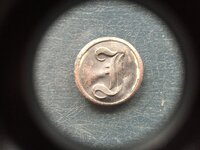
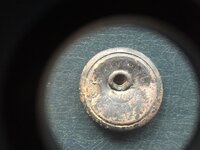
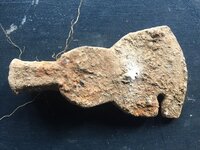
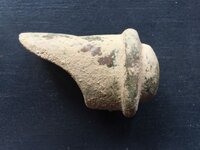
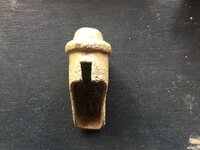
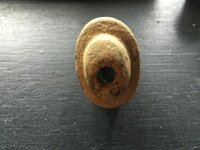
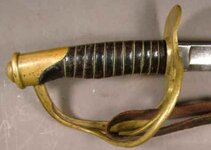 Last image source: RelicMan.com
Last image source: RelicMan.com
I’d had a very stressful week at work so I told my wife Friday evening, “I need some peace and solitude. I’m going relic hunting tomorrow.” So I went to one of my favorite locations here in the Shenandoah Valley. The property is an old house/farm and also had a thriving, turn of the century business located on it at one time. It is now pasture land in a very remote part of the Valley.
I also wanted to take my new Makro Racer 2 with the NEL Snake coil on it and see if it could live up to its reputation for unmasking in heavy iron. It did and in stellar fashion.
From the mid-1800’s until the early 20th century, the property was owned by a man who served with Stonewall Jackson and fought at Chancellorsville. He was a member of a cavalry unit. Even though this location is one of my favorites, it is also one of the most challenging as it is littered with iron and some modern trash as well. But the real challenge is the electric cattle fence that surrounds the property on all sides and the areas I’m hunting are all within 40 feet of the fence. The electric impulses drives every detector I’ve ever used there absolutely crazy (AT Pro, T2SE, XP Deus, Nokta FORS Relic). One has to listen in between the constant falsing to determine if a signal is real or not.
So yesterday started a bit slow - as usual. It takes a while to get used to the falsing. I spent the first two hours digging horseshoes and other iron pieces such as square nails, etc. I was going to pack it in and move to another location that I’ve had some success at recently but, instead, decided to move to another spot at this same location where I’ve recovered a number of relics including a holed 1866 shield nickel, pewter buttons and a Union General Service Eagle button.
This is where the iron is REALLY thick. Multiple signals with EVERY swing of the coil. Then I got a signal that was reading like a button 40-45. I dug the plug and out pops a Confederate Script I button with the “Isaac, Campbell & Co.” of London backmark. These buttons were imported by the Confederacy during the blockade. That company has an interesting history and there’s even a book about the company: Supplier to the Confederacy: S. Isaac Campbell & Co, London by David C. Burt.
The ground was so dry and the digging so hard and good signals so few, I was satisfied enough to go home. But something told me to keep at it. The next signal signified deep iron so I dug it just to see what it was. A period axe head. I love old axe heads and this one will clean up and display nicely. Right after that and right up against the electric fence with the Makro chattering like crazy, I got a nice, solid, high repeatable signal: 85-90. I’m thinking: “It’s either big silver or another buried beer can.” It was neither. It was an 1860 Model Cavalry sword pommel. The finish is crude and rough and “as cast” indicating it was never polished as were Union manufactured sword pommels. In other words, it's a Confederate saber pommel. It’s quite likely part of a saber that once belonged to the cavalry veteran who rode with Stonewall.
I think I can make out a very faint maker's mark but will need to clean the encrustation off to confirm. Any recommendations there?
Nothing like recovering Confederate relics to relieve stress.






 Last image source: RelicMan.com
Last image source: RelicMan.com
Last edited:
Upvote
15





